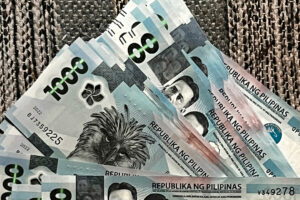THE PESO climbed against the dollar on Thursday to close at the P57 level amid uncertainty over the US Federal Reserve’s monetary easing cycle.
The local unit closed at P57.94 per dollar on Thursday, strengthening by 14.8 centavos from its P58.088 finish on Wednesday, Bankers Association of the Philippines data showed.
The peso opened stronger at P58.03 against the dollar. It traded better than Wednesday’s close the entire session as its worst showing was at just P58.05, while its intraday best stood at P57.915 versus the greenback.
Dollars exchanged went up to $1.41 billion on Thursday from $1.25 billion on Wednesday.
“The peso appreciated after the latest Fed minutes hinted at a potential deceleration or termination of the US central bank’s quantitative tightening activity,” a trader said in a Viber message.
The local unit rose as the minutes signaled a pause in the US central bank’s easing cycle until inflation improves, similar to earlier hints by most Fed officials recently, Rizal Commercial Banking Corp. Chief Economist Michael L. Ricafort said in a Viber message.
For Friday, the trader said the peso could weaken anew on potentially hawkish signals from Fed officials overnight.
The trader expects the peso to move between P57.85 and P58.10 per dollar, while Mr. Ricafort sees it ranging from P57.85 to P58.05.
US President Donald J. Trump’s initial policy proposals raised concern at the Federal Reserve about higher inflation, with firms telling the US central bank they generally expected to raise prices to pass along the cost of import tariffs, policy makers said at a meeting held about a week after Mr. Trump’s Jan. 20 inauguration, Reuters reported.
Participants at the US central bank’s Jan. 28-29 meeting “generally pointed to the upside risks to the inflation outlook,” rather than risks to the job market, according to the minutes from the meeting, which were released on Wednesday. “In particular, participants cited the possible effects of potential changes in trade and immigration policy, the potential for geopolitical developments to disrupt supply chains, or stronger-than-expected household spending.”
While still having faith that price pressures will ease in coming months, “other factors were cited as having the potential to hinder the disinflation process,” the minutes said, including the fact that “business contacts in a number of (Fed) districts had indicated that firms would attempt to pass on to consumers higher input costs arising from potential tariffs.”
Participants also noted that some measures of inflation expectations, a key concern for the Fed, “had increased recently.”
Financial markets were little changed after the release of the minutes, with interest rate futures indicating the Fed’s likely first, and perhaps only, rate cut of 2025 would occur in July.
Policy makers at last month’s meeting agreed they should hold interest rates steady until it was clear that inflation, largely stalled since the middle of 2024, would dependably fall to the central bank’s 2% target.
The uncertainty surrounding Mr. Trump’s plans has added to their reluctance to reduce rates any further.
The Fed kept its benchmark interest rate in the current 4.25%-4.5% range at its meeting last month, and officials since then have said they are in no rush to cut rates again until they are more certain inflation will decline to the 2% target from current levels around half a percentage point above that level.
In another sign of how fiscal policy may impact central bank decision-making, the minutes said “various” policy makers noted it may be appropriate to consider slowing or pausing the Fed’s ongoing shrinking of its balance sheet in light of federal “debt ceiling dynamics.” — A.M.C. Sy with Reuters
